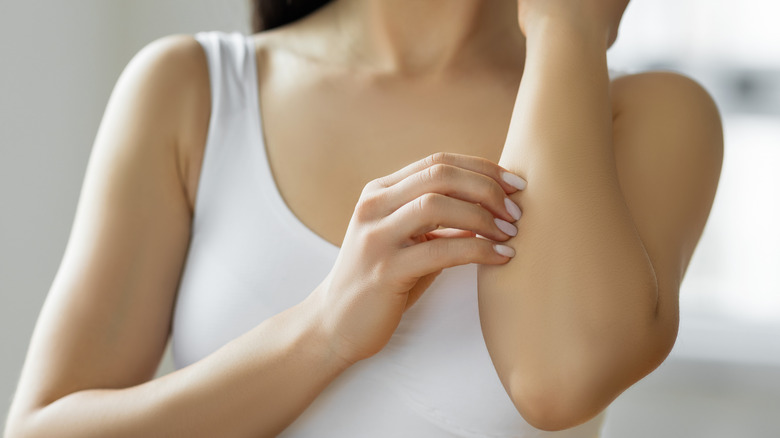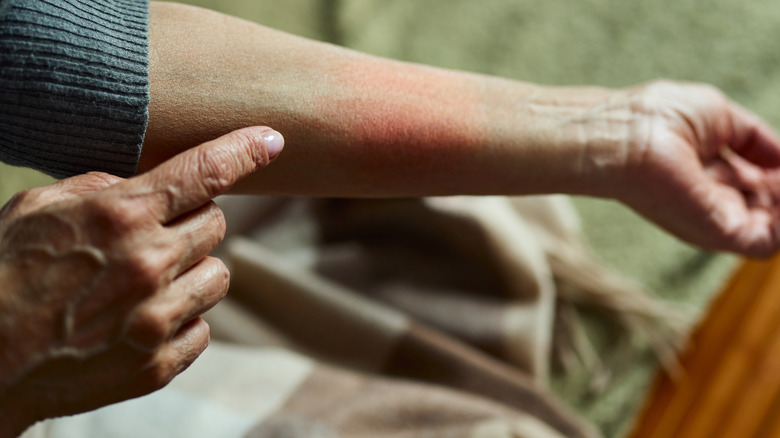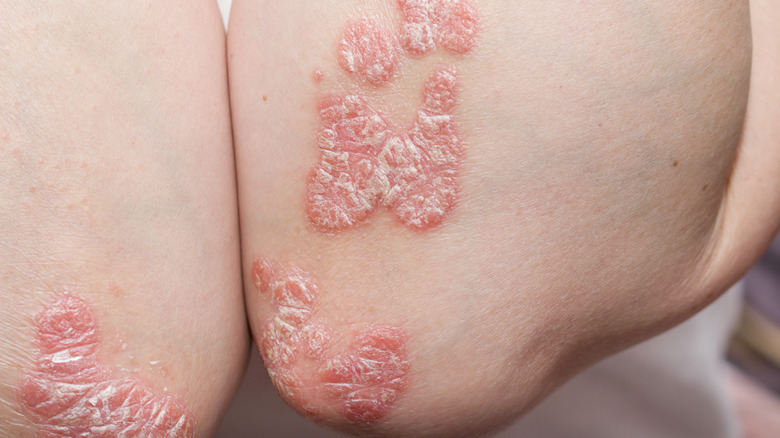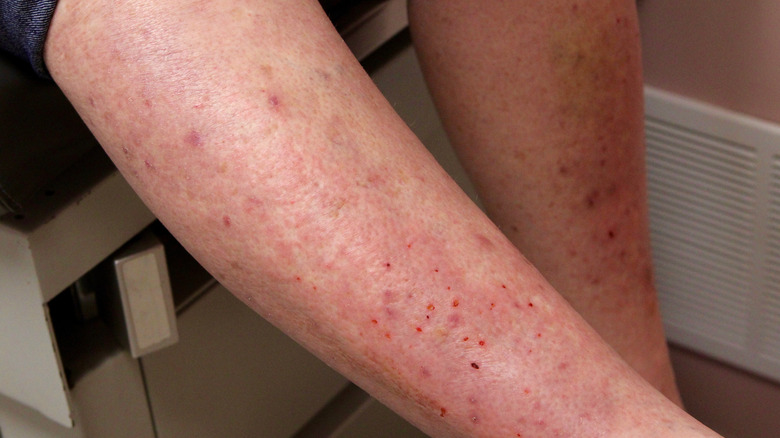What's Really Causing Those Bumps On Your Elbows
If you've recently noticed bumps forming around your elbows, you may be wondering where they came from. While the culprit may be dry skin, a minor rash, a food allergy, or a bug bite, bumps can sometimes indicate a health condition. Diagnosing the cause of your bumps can help you get treatment.
Among the most common causes of bumps on the elbows are eczema and psoriasis. Eczema is an inflammatory skin condition, while psoriasis is an autoimmune disorder. Both, however, can lead to elbow bumps and itchiness. When no itchiness is present, it could be keratosis pilaris. In addition to affecting the elbows, bumps also appear on your arms. Bumps limited to the elbows could also be from dermatitis herpetiformis, which is an autoimmune skin disorder.
Learn the symptoms of each skin condition to help narrow down where your skin bumps may come from. We'll also provide some applicable home remedies to smoothen out your bumpy elbows. Knowing when to treat it at home or call your healthcare provider can save you time and money.
Elbows and eczema
Don't be scared about bumps on your elbows because eczema is a common cause of dry, patchy, and itchy skin and blisters in that area. According to the Cleveland Clinic, about 31 million Americans are affected by eczema, and infants are more susceptible to this disorder. When your skin is triggered, eczema can strike just about anywhere on your limbs, face, trunk, and elbows. This type of skin inflammation is more prevalent in those with allergies, hay fever, and asthma.
The National Eczema Association points out four types of eczema that might be the culprit behind your bumpy elbows. Atopic dermatitis is more common in small children and causes dry patches of itchy skin, while nummular eczema causes arm lesions. Dyshidrotic eczema blisters come with a burning sensation, and neurodermatitis creates small patches.
Lifestyle changes and alternative therapies can be part of your treatment process, like moisturizing and practicing meditation. Medical News Today also notes that antihistamines, topical creams, and immunosuppressants can treat itchy elbows. The treatment depends on the type and trigger, which require a medical diagnosis.
Contact dermatitis can lead to little bumps
Have you ever brushed up against something that made you instantly itchy, only to see your friend make contact with the same object and have zero reaction to it? When you encounter something that creates a rash or itchy response, it's called contact dermatitis, which is classified as a type of eczema. The Cleveland Clinic breaks contact dermatitis down into two different types: allergic and irritant. The names give away the triggers, meaning allergic contact dermatitis means you encountered an allergen, like nickel or preservatives, while irritant contact dermatitis means you encountered an irritant, like detergents or cleaners.
Tracking down the cause of your contact dermatitis bumps can be a little tricky. But you'll typically notice the irritated area is limited, like your elbows, since they are what came into contact with the allergen or irritant. Some professions create a higher risk for contact dermatitis (e.g., florist, construction work, cleaner, janitor, or health care provider), given their repeated exposure to specific allergens, per the Mayo Clinic. This is particularly true since contact dermatitis can start after repeated exposure over time. Basically, your body says, "I've had enough." Treatments are the same as those for eczema but can include limiting your exposure to the smell, metal, or chemical causing the problem.
Psoriasis can be the cause of bumpy elbows
Irritated, bumpy elbows can look like several conditions. Psoriasis is one of them. This skin disease leaves an itchy rash, scaly patches, and blisters. The most common form is known as plaque psoriasis. Caused by an immune system malfunction, this autoimmune disorder makes the skin create new skin cells sooner than it should, leading to buildup (via Healthline). These plaques can become quite painful and lead to the dry, flaky bumps you're experiencing on your elbows. While plaque psoriasis is the most common, guttate psoriasis, triggered by a bacterial infection, can also be the cause, per the Mayo Clinic.
According to a paper published in JAMA Dermatology, the prevalence of psoriasis in the U.S. in 2021 was around 3%. The cause is typically unknown, for the most part, but initial triggers of the immune system can range from a bad sunburn to strep throat (per Healthline). It runs in families, and medications, smoking, and obesity can increase your risk.
After diagnosis by a dermatologist or healthcare professional, treatment options can range from topical steroids to medications like methotrexate. Coal tar, retinoids, and salicylic acid might also be used. Some patients benefit from UV therapy. Those with severe psoriasis might see improvement with oral or injected medications.
Dermatitis herpetiformis might be to blame
Elbow bumps can also be related to celiac disease. According to an article published in Canadian Family Physician, dermatitis herpetiformis appear in the form of little blisters on the elbows, knees, neck, and scalp. The little blisters are an external manifestation of celiac disease and can accompany gastrointestinal issues or happen on their own. Statistics show less than 20% of dermatitis herpetiformis sufferers typically have gut symptoms of celiac disease, per the National Institute of Diabetes and Digestive and Kidney Diseases (NIDDK).
According to NHS Inform, 1 in every 10,000 people is afflicted with this condition. It is also more common in men and typically doesn't appear until age 15. These itchy blisters are known to burst when scratched and can cause severe stinging.
Since gluten is the culprit of the autoimmune disorder, cutting it out of your diet is necessary to get the blisters to go away. Your provider might also prescribe a topical cream, sulfone dapsone, to help relieve the itch and burning. You also have a 5% chance of having this skin condition if you have a first-degree relative diagnosed with it (via NIDDK). Those with other autoimmune disorders (i.e., hypothyroidism) are also susceptible.
Keratosis pilaris can cause elbow irritation
Are the elbow bumps on your toddler or teenager? You might be dealing with a condition known as chicken skin, or keratosis pilaris. This common condition can create discolored bumps and dry skin that can itch on the arms, elbows, and shoulders. But it can appear on any area with a hair follicle.
According to the Cleveland Clinic, these harmless bumps are due to excess keratin on the skin and typically clear up with age. The hormone surge in puberty can make it more noticeable in teens, which is why adolescents can be hit hard with symptoms. The American Academy of Dermatology Association (AAD) notes that those with fair skin, eczema, asthma, diabetes, and obesity can also be subject to these little bumps.
Interestingly, reaching the age of 30 is typically all it takes to get rid of this condition (via Healthline). In the meantime, though, if your skin is itchy or dry, try applying moisturizing treatments with lactic acid. Exfoliation treatments, chemical peels, and retinol creams can also be beneficial in unclogging the pores and loosening dead skin. Humidifiers and warm baths can open your pores to remove the excess keratin.
Home remedies for treating itchy elbows
Bumps on the elbows are beyond irritating, especially if they itch. Trying different treatment options at home to clear up the breakout might be worthwhile before making an appointment with your doctor, since simple solutions can quickly clear up dry or irritated skin.
One standard treatment for dry, itchy elbows is exfoliation. This can work for keratosis pilaris, too. According to the AAD, apply a natural or chemical scrub and use slow circles with a cloth or exfoliator for 30 seconds. Moisturizing is another key to trying to erase elbow bumps. Mild irritation or a slight rise in the skin might be helped by adding a thick moisturizer daily to your elbows and other areas of the skin. You can also try deep moisturization by taking a bath before bed, applying a thick moisturizer or cream to the elbows, and locking the moisture to the skin overnight with a long-sleeved shirt or wrap (via AAD).
Healthline suggests considering your tops and detergent. Some clothing materials, like spandex or polyester, can become potential irritants to the skin. Limiting exposure to these materials can ensure your elbows stay hydrated and bump-free. It may also be a good idea to steer clear of detergents with irritants, like specific chemicals and fragrances.
When to call a doctor about elbow bumps
Some conditions, like psoriasis and dermatitis herpetiformis, require diagnosis by a medical professional and treatment since they are related to an autoimmune disorder. But there are other conditions causing bumpy elbows that should have you running for the phone.
For example, a bump on the elbow that's extremely painful and draining could result from a bacterial infection. A slow-growing pink, white, or skin-colored bump on your elbow or other areas of the body is a sign of basal cell carcinoma, a type of cancer. Watch for bumps that appear after an injury and come with limited elbow mobility since they can be due to a fracture, states Healthline. Other severe conditions requiring medical attention include scabies, an itchy parasite, and rheumatoid arthritis, an autoimmune and inflammatory disease. Not getting treatment for these conditions right away can lead to more serious consequences down the road.
Specific things to watch for from the bump on your elbow are worsening pain, growth, and drainage. You might also want to pick up the phone if your at-home treatments aren't making any progress with itchy or swollen bumps.








